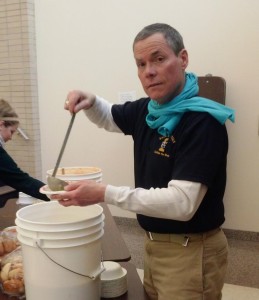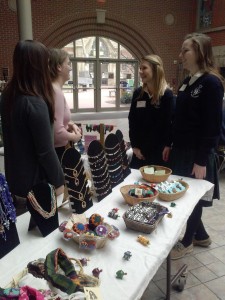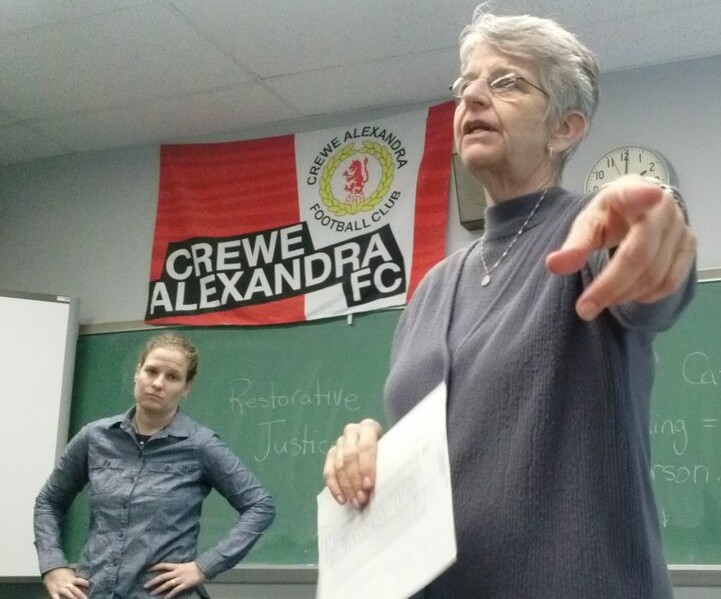by Dominic Gideon ’14
On Friday, March 8, while most students were at school or, for Ignatius students, sleeping in during the day off, about 540 students from 23 different schools packed St. Mary’s Chapel to kick off the Breaking Barriers Summit. Bishop Richard Lennon celebrated the Eucharist to begin the event whose purpose was to reveal the social injustice around the world as well as locally and to encourage the teens to go out and be the voice for those suffering. The Gospel of the mass, the parable of the Good Samaritan, went perfectly with the theme of the day: “making the invisible visible.” Bishop Lennon emphasized that connection in his homily in which he lauded the students for their willingness to come and urged them to make a difference in the world with the knowledge and vigor from the summit.
After the bishop set the mood of the event with Communion and his powerful words, the heart of the summit was almost ready to commence.
The students, coming from all diocesan high schools and even two outside of the diocese, were a very eclectic group of teenagers, ranging from all four grades, with much diversity, and coming from many different areas of Greater Cleveland. The one group of people who were the large majority was the female population. There were numerous reasons why these students chose to attend: some came because of projects they had to do relating to one of the discussed topics, some were recommended by their teachers to go, some came for a nice, relaxing day off of school, and many teens like sophomore Ryan Wynne of Lake Catholic just “thought it would be a good opportunity to learn a lot of new things.”

Whatever their gender, school, grade, or motivation they were all jammed inside the chapel, filling all the roughly 500 seats and then some, as Mr. Pacetti and Mr. Evans (the Ignatius teachers of CSPJ) gave information about the day and handed out everyone’s personal schedule.
Thanks to long and careful planning by the Catholic Schools for Peace and Justice (CSPJ), the event was configured in an effective and orderly manner. The day was made so that the students were “completely immersed in the knowledge which surrounds social justice,” as CSPJ member Caroline Mills ’14 of Saint Joseph Academy puts it. Each student was assigned four classroom speakers on topics such as immigration, human trafficking, violence in the world, poverty, those with disabilities, or prison life. Even though the classes were only on the second an third floors of the Main Building, National Honor Society members were there to help any student who managed to get discombobulated. There were over 40 speakers from all around the area with a vast range of occupations and backgrounds which all uniquely qualified them to talk to the high schoolers.
In the middle of these sessions was lunch along with an organizational fair, and the keynote speech given by the nationally renowned author and speaker Sr. Helen Prejean. The simple lunch of Capri Sun, soup, bread, and a cookie gave the lunchroom a soup kitchen feel as the students waited in long lines to get modest servings of soup from big white buckets. Nonetheless, students didn’t grumble much, and the experience made them further think of the people the day was focused on: “the invisible.”
After the teens finished up lunch many took the rest of the session to check out stands put up by various organizations which centered around themes of the day, like disabilities, fair trade, and human trafficking. Although not having an abundance of time to look around, students still were able to grab some pamphlets and get on some emailing lists which interest them.
Then came the pinnacle of the day: Sr. Helen Prejean. The sweet yet passionate sister from Louisiana wrote the book Dead Man Walking which has been made into a movie and a play. She has a very busy schedule in which she spends going around the country to give talks to all sorts of people. And there’s a good reason why so many people in America lobby for the little nun from down South to come to speak to them.

“What grace does is it wakes you up!” Sr. Prejean exclaimed in her thick Cajun accent as her voice echoed in the Breen Center. She talked about her ignorance to social justice when she was in high school and tried to make sure that was a problem for the hundreds of students in front of her. Initially one might not think her to be too intellectual, with her Southern twang and her occasional omitting of an are or is every now and then, but as she spoke on, one could see the true English major in her.
“[Social justice] is a constitutive part of the Gospel of Jesus,” she emphasized, and then came her famous and compelling story. “He asked me if I wanted to be the pen pal with a guy on death row, and I said ‘Sure’!… The problem was he wrote back,” Sr. Prejean said in a humorous growl.
She went on to tell about the relationship she formed with Patrick Sonnier, and everything that lead them into the execution chamber that fateful day which Sr. Prejean said, “changed her life.”
Sonnier and his brother committed a gruesome murder and Sister did not deny that in the least, but she still somehow believed the man should have kept his life. “What makes you heal is love of community, not just watching for 15 years [for the] state to kill somebody. The death penalty revictimizes us,” she said, talking about the often grim and rehashing reminder for the victim’s family as they go through the execution of the culprit.
Then came the climax of the story: “He didn’t want me to see the execution… I said ‘Pat, I don’t know what it’s gonna do to me, but I’m gonna be there for you; and you look at my face, and I’m gonna be the face of Christ for you.'”
Proceeding this tragic story she then urged the crowd to be the light of God in the world. After the speech she explained, “the fire gets lit by the Holy Spirit. We are the kindling.”
For many students, Sr. Helen Prejean was the highlight of the day; but overall, the teens got a lot out of the experience. “We have knowledge and the background of all the issues so that we can actually speak out against [injustice] and make change,” said Melissa Drpac ’14 of Saint Joseph Academy, president of their CSPJ team.
At the end of all the activities, Mr. Evans went back in front of the crowd, this time at the Breen Center, and talked about how the students can move forward from the event and truly make the invisible visible. Many students, like junior Maddie Levand ’14 of Gilmour Academy, felt an inclination to act upon the social injustice they just learned about: “Now that I have a different understanding of it all, I want to reach out more.”
The most a teenager usually will do is contact their legislature and tell them the importance of certain social justice issues, but that is not the limit. Students can join or start clubs, peacefully protest (like at an execution), or just become more educated on topics so as to better fight for them when the time comes.
Below you will find some extras from this story: a short audio clip from Sr. Helen Prejean’s keynote address, and a Storify thread collecting social media posts from the day.






